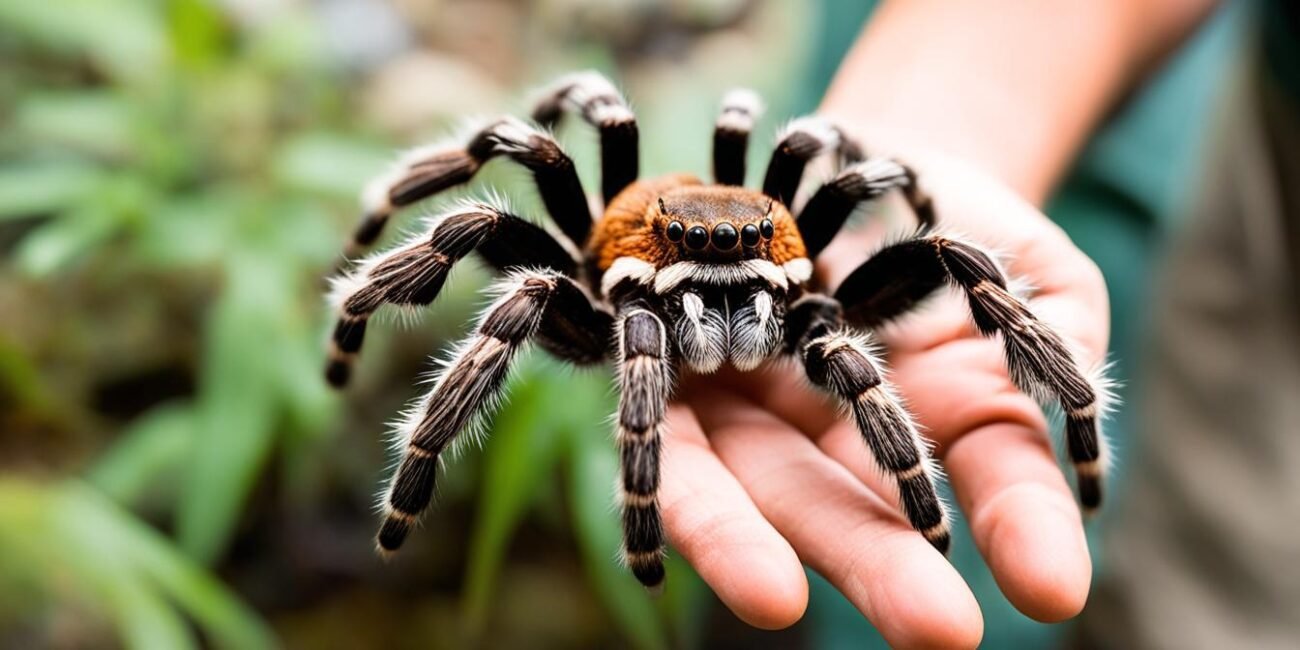Tarantula handling is a debated topic in the hobby, with some keepers endorsing it and others considering it unsafe. It is important to note that tarantulas are not domesticated animals and can be very unpredictable. When handling tarantulas, it is crucial to dress appropriately, be gentle, and use forceps or a capture cup to pick them up.
It is also recommended to move them on a flat surface and avoid playing around or poking them. Old World tarantulas have more potent venom and should never be handled. Always be aware of the risks and use caution when handling tarantulas.
Key Takeaways:
- Handle tarantulas with caution, as they are unpredictable animals.
- Dress appropriately and use forceps or a capture cup to pick them up.
- Avoid playing around or poking tarantulas during handling.
- Old World tarantulas should never be handled due to their potent venom.
- Always be aware of the risks and use caution when handling tarantulas.
The Desire to Handle Tarantulas
Many tarantula keepers feel that handling their spiders is a major accomplishment and a way to feel more bonded to their pets. The act of handling tarantulas can provide a sense of pride and connection with these intriguing creatures. However, it is important to acknowledge that handling discussions often lead to heated debates within the tarantula-keeping community. There are differing opinions on the necessity and safety of tarantula handling.
As responsible tarantula handlers, we aim to provide balanced insight on this topic. While some individuals endorse and practice tarantula handling, others consider it unnecessary and even unsafe. It is crucial for beginners to understand that handling tarantulas is not a requirement to be considered credible in the hobby. The decision to handle tarantulas should be based on personal preferences, research, and an assessment of the risks involved.
Let us emphasize that handling tarantulas should not be viewed as a measure of a keeper’s worthiness or dedication. It is essential to prioritize the well-being and safety of both the keeper and the spider. Tarantulas are fascinating creatures with unique behaviors and instincts. Understanding and respecting their nature is paramount in providing responsible care.
Handling Pet Tarantulas: A Personal Choice
Handling pet tarantulas is a personal choice that can vary among keepers. Some individuals find joy and fulfillment in the tactile experience of holding their spiders, which they believe fosters a deeper connection and appreciation for these captivating arachnids. However, it is crucial to approach tarantula handling with caution and respect.
“The decision to handle tarantulas should be based on personal preferences, research, and an assessment of the risks involved.”
For beginners, it is important to recognize that handling tarantulas is not a necessary component of responsible tarantula ownership. It is possible to provide excellent care and enrichment for your tarantula without handling them directly. Bonding with your pet can be achieved through observation, maintaining an enriching environment, and practicing good husbandry.
The Importance of Education and Understanding
Before attempting to handle tarantulas, education and understanding play vital roles. Researching the specific species of tarantula you own or plan to handle is essential for making informed decisions. Each species has its own unique temperament and behavior, and becoming familiar with these characteristics will help you gauge the appropriateness of handling.
By acquiring knowledge about tarantula behavior, handling techniques, and potential risks, you can better assess your readiness to handle tarantulas responsibly. Additionally, watching tutorials by experienced keepers or seeking guidance from reputable experts can provide valuable insights and enhance your understanding of safe handling practices.
The Risks of Tarantula Handling
Tarantulas, like many wild animals, are not domesticated pets. They have their own instincts and behaviors, which can be unpredictable. It is important to acknowledge the risks associated with tarantula handling and make an informed decision accordingly.
When handling tarantulas, there is a potential for accidental injury to either the spider or the handler. Tarantulas may bite when they feel threatened or agitated, and some species possess venom that can cause varying degrees of discomfort or reaction. Additionally, tarantulas possess urticating hairs, which they can flick as a defense mechanism. These hairs can cause irritation on contact with human skin or mucous membranes.
Tarantula handling should always prioritize the well-being and safety of both the spider and the keeper. It is crucial to consider these risks, maintain a calm and controlled environment, and handle tarantulas responsibly.
The Decision is Yours
Tarantula handling remains a contentious topic within the hobby, with valid arguments on both sides. As responsible tarantula keepers, we advocate for making informed decisions based on individual circumstances, preferences, and the specific needs of the tarantula species in question.
We recognize that some individuals may choose to handle tarantulas for personal reasons, while others may opt to observe and appreciate them from a respectful distance. Ultimately, the decision to handle tarantulas is a personal one, and each keeper must assess the risks and benefits to ensure the well-being of both themselves and their pet spiders.
Remember, responsible tarantula handling is not defined by physical interaction but rather by providing appropriate care, creating enriching environments, and fostering a deep understanding and respect for these incredible creatures.
Understanding Tarantula Behavior
Tarantulas are fascinating creatures, but it’s important to understand their behavior before attempting to handle them. Unlike domesticated animals, tarantulas are not recognized as intelligent creatures and do not become “tame” through handling. Each tarantula has its own unique temperament, and their tolerance for handling can vary.
However, it’s crucial to remember that a previous incident-free handling experience doesn’t guarantee future safe interactions. Tarantulas, being wild animals, can be highly unpredictable. They have evolved various defense mechanisms to protect themselves, such as biting and flicking their urticating hairs.
Urticating hairs are specialized hairs found on the abdomen of tarantulas. When threatened, they can rub their legs against their abdomen, releasing these irritating hairs into the air. These hairs can cause pain, itching, and even allergic reactions if they come into contact with the skin or eyes.
Recognizing the signs of stress or aggression in tarantulas is crucial before attempting to handle them. Increased defensive postures like lifting their front legs, rearing up, or flicking their hairs are signs that they may not be in the mood for handling.
Understanding tarantula behavior can help you make informed decisions about handling and prioritize the safety of both you and your spider.
The Relationship Between Tarantula Size and Temperament
While tarantula behavior can vary between species and individuals, there is a general trend between size and temperament. Larger species of tarantulas tend to have milder temperaments and are generally more docile. They are less likely to bite or flick their urticating hairs compared to smaller or more aggressive species. Nevertheless, this is not a strict rule, and proper caution should still be exercised when handling any tarantula, regardless of its size.
| Tarantula Size | Potential Temperament |
|---|---|
| Small – Medium | More skittish, defensive, and prone to flicking urticating hairs |
| Large – Extra Large | Tend to be more docile and less prone to aggressive behaviors |
*The table above provides a general guideline regarding the relationship between tarantula size and temperament. However, this may vary between species and individual tarantulas.
Tarantula Handling Precautions
When it comes to handling tarantulas, responsible tarantula handling requires taking certain precautions to ensure the safety of both the keeper and the spider. Here are some essential tips to follow:
Wear Protective Gear
To protect against bites and urticating hairs, it is recommended to wear gloves, long sleeves, and long pants tucked into socks when handling tarantulas. This will minimize the risk of direct contact with the spider’s defense mechanisms.
Use Tools for Handling
Using forceps or a capture cup is highly recommended to prevent injury to the spider during handling. These tools allow for a controlled and safe grip on the tarantula without causing stress or harm.
Move Them on a Flat Surface
When handling tarantulas, always place them on a flat surface to minimize the risk of them falling or getting injured. This provides stability and reduces the chances of accidents occurring.
Avoid Airflow
Tarantulas are extremely sensitive to airflow, so it is crucial to avoid blowing on or breathing near the spider during handling. Sudden movements or drafts can startle the tarantula and lead to defensive reactions.
Quarantine Other Pets
If you have other pets, it is important to keep them away during tarantula handling sessions. This ensures that there is no interference or potential harm caused by curious animals that may not understand the delicate nature of tarantulas.
First Aid Preparedness
Always have first aid tools readily available in case of emergencies. This includes items such as antiseptic solution, sterile gauze, and bandages. Being prepared will help address any injuries promptly and effectively.
By following these tarantula handling precautions, you can ensure a safe and responsible approach to interacting with these fascinating creatures. Remember, the well-being of both the keeper and the tarantula should always be a top priority.
Tarantula Handling Tips for Beginners
For beginners interested in handling tarantulas, it is crucial to undertake extensive research and educate ourselves before attempting to handle these fascinating creatures. Tarantulas are not domesticated animals, and their behavior can be unpredictable, requiring us to be well-informed and prepared.
Here are some tips to consider before handling tarantulas:
- Know the species: Each tarantula species has its own temperament and behavior. It is essential to understand the specific characteristics of the tarantula you plan on handling. Some species are more docile and tolerant of handling, while others are aggressive and should never be handled.
- Observe their behavior: Spend time observing your tarantula in its enclosure before attempting to handle it. This will allow you to get a sense of its normal behavior and recognize any signs of stress or aggression.
- Create a safe handling environment: Set up a designated area where you can handle your tarantula safely. Make sure the space is secure, well-lit, and free from potential hazards or escape routes.
- Use the right tools: Invest in a pair of long forceps or a capture cup to safely pick up and move your tarantula. These tools provide a greater distance between you and the spider, reducing the risk of accidental injury.
- Be calm and gentle: Approach your tarantula with a calm demeanor and gentle movements. Sudden jerks or loud noises can startle them and potentially lead to defensive behavior.
Remember, tarantula handling is not essential to be a good tarantula owner. It is important to prioritize the well-being and stress levels of the spider. Some tarantulas may prefer to be left alone and thrive better without regular handling.
“Handling tarantulas isn’t a requirement for enjoying them. In fact, some would argue that keeping them undisturbed is a more natural and responsible approach. It’s perfectly fine to appreciate tarantulas from a distance and provide them with a stress-free environment.” – Experienced Tarantula Keeper
By following these tips and approaching tarantula handling with caution and respect, you can ensure a positive experience for both you and your tarantula.
First Aid Tools for Tarantula Handling
It is crucial to have the necessary first aid tools on hand in case of any accidents while handling tarantulas. Here are a few essential items to include in your tarantula handling first aid kit:
| First Aid Kit Essentials |
|---|
| Gloves |
| Antiseptic wipes or solution |
| Tweezers |
| Adhesive bandages |
| Hydrocortisone cream |
| Benadryl (for allergic reactions) |
Having these first aid supplies readily available will ensure that you are prepared to handle any minor injuries or reactions that may occur during the handling process. If a more serious incident occurs, seek medical attention immediately.
Benefits and Drawbacks of Tarantula Handling
While tarantula handling can help some of us see these creatures as less scary and appreciate them as amazing animals, it is important to recognize that handling does not benefit the spider and may cause stress or injury. Many experienced keepers choose not to handle their tarantulas and still provide excellent care for their pets. The decision to handle tarantulas should be based on individual preferences and understanding of the risks involved. It is crucial to remember that handling is not a measure of a keeper’s worthiness or dedication to the hobby.
| Benefits of Tarantula Handling | Drawbacks of Tarantula Handling |
|---|---|
|
|
Many experienced tarantula keepers believe that providing a stress-free and secure environment, along with proper tarantula care, is the most responsible approach. Responsible tarantula handling involves prioritizing the well-being of the spider and respecting its natural behavior and needs.
While handling tarantulas can be a personal choice, it is essential to consider the potential risks and drawbacks. Handling should always be done responsibly and with knowledge of the species-specific care requirements. By focusing on providing excellent care and creating a suitable environment, keepers can ensure the well-being of their tarantulas without the need for handling.
Old World Tarantulas and Handling
When it comes to handling tarantulas, there are certain species that require extra caution due to their potent venom and defensive behavior. These spiders, known as Old World tarantulas, can be found in Europe, Africa, and Asia.
Handling Old World tarantulas is not recommended for several reasons. Firstly, these species have more aggressive temperaments, making them more likely to bite as a defense mechanism. Secondly, their venom is more potent, and a bite from an Old World tarantula can result in severe symptoms such as extreme pain, vomiting, cramping, and heart palpitations. Due to these risks, it is crucial to prioritize safety and avoid handling these species.
Instead, it is best to observe Old World tarantulas from a safe distance and appreciate their beauty and fascinating behavior. By respecting their natural instincts and avoiding unnecessary stress, we can ensure the well-being of both the keeper and the spider.
Handling Tarantula Bites and Urticating Hairs
Tarantula bites can be painful and cause various symptoms. It’s essential to know how to respond if a bite occurs and take appropriate precautions during handling to minimize the risk.
When a tarantula bite happens, it’s important to clean the wound thoroughly with mild soap and water. Apply an antiseptic and cover the wound with a clean bandage to prevent infection. If there are signs of infection or severe allergic reactions, such as excessive swelling, redness, or difficulty breathing, seek immediate medical attention.
Even species with weaker venom can still deliver painful bites, so handling tarantulas should always be done with caution. Always wear gloves and consider using forceps or a capture cup to minimize the risk of being bitten. Remember that tarantulas are not domesticated animals and can exhibit unpredictable behavior, so handle them with care.
In addition to bites, tarantulas also have urticating hairs on their abdomens, which they can flick as a defense mechanism. These hairs can cause skin irritation and discomfort, so it’s important to avoid touching the abdomen during handling. After handling a tarantula, make sure to wash your hands thoroughly to remove any urticating hairs that may have been transferred.
Being aware of tarantula bite risks and taking handling precautions is crucial for both the keeper and the spider’s safety. By following these guidelines, you can minimize the chances of bites and ensure a safe and enjoyable experience when handling tarantulas.
| Tarantula Bites | Urticating Hairs |
|---|---|
|
|
The Importance of Research and Experience
Before attempting to handle tarantulas, it is crucial to do extensive research, watch tutorials by experienced and trusted experts, and gain knowledge about the specific species being handled. We understand that tarantula handling can be an exciting prospect, but responsible tarantula handling requires preparation and understanding.
Experience is also essential in gaining the necessary skills and confidence to handle tarantulas safely. It is important to develop a deep understanding of tarantula behavior and body language, as it helps in interpreting their reactions during handling. By honing your observation skills, you can anticipate their movements and ensure a safer interaction.
We strongly advise beginners to start with smaller, docile species before handling more challenging ones. This gradual approach allows you to gain experience and build confidence in your handling abilities. Remember, proper handling techniques come with practice and may vary depending on the tarantula species.
Handling tarantulas should not be taken lightly and should only be attempted by those who are well-informed, comfortable, and have a plan in place for potential emergencies. It is crucial to prioritize the safety and well-being of both the keeper and the spider in all handling interactions.
“Handling tarantulas is a privilege that comes with responsibility. Take the time to learn about your tarantula’s temperament, body language, and care requirements. The more knowledge you have, the better equipped you’ll be to handle your tarantula safely.”
Benefits of Research and Experience in Tarantula Handling
Research and experience in tarantula handling offer several benefits:
- Enhanced Safety: A well-researched and experienced handler is better equipped to identify potential risks and avoid mishaps during handling.
- Understanding Tarantula Behavior: Thorough research helps you develop a deeper understanding of tarantula behavior, enabling you to make informed decisions during handling.
- Building Trust: Consistent, gentle handling helps build trust between you and your tarantula, allowing for a more comfortable and stress-free interaction.
- Improved Bonding: Proper handling techniques, complemented by a good understanding of your tarantula, can help strengthen the bond between keeper and spider.
Recommended Resources and Educational Materials
| Resource | Description |
|---|---|
| Books | Books such as The Tarantula Keeper’s Guide by Stanley A. Schultz and Marguerite J. Schultz provide detailed information on tarantula care and handling. |
| Online Forums | Active online tarantula communities, like Arachnoboards, provide valuable insights and advice from experienced keepers. |
| Webinars and Workshops | Participating in webinars and workshops conducted by reputable tarantula experts can offer hands-on guidance and expertise. |
| YouTube Channels | YouTube channels like Tarantula Haven and The Dark Den provide educational videos on tarantula care, handling, and species-specific advice. |
Prioritize your tarantula’s safety and well-being by investing time in research and gaining experience. It is essential to understand and respect their needs and natural behavior. Remember, responsible tarantula handling goes hand in hand with knowledge and experience.
Conclusion
Tarantula handling is a topic that divides opinions among tarantula keepers. While some individuals find joy in handling their tarantulas to strengthen their bond, it’s important to understand that handling is not a necessity to be a responsible tarantula owner. Tarantulas are not domesticated creatures and can exhibit unpredictable behavior, making handling potentially risky.
As natural defense mechanisms, tarantulas may bite or flick urticating hairs, causing pain and discomfort. To ensure the safety of both the keeper and the spider, it is crucial to prioritize safety precautions, conduct thorough research, and gain experience before attempting to handle a tarantula. Always remember that the decision to handle should be based on individual preferences and a deep understanding of the associated risks.
In the end, whether you choose to handle your tarantula or not, what matters most is providing proper care and a suitable environment for your pet. Tarantula care goes beyond handling and involves creating a suitable habitat, monitoring their health, and providing a balanced diet. The well-being of your tarantula should always be the top priority, and responsible care should be the primary focus of every tarantula owner.
FAQ
Can I handle my tarantula?
Tarantula handling is a debated topic in the hobby. While some keepers choose to handle their tarantulas, it is important to understand that tarantulas are not domesticated animals and can be unpredictable. It is crucial to prioritize safety and make an informed decision before attempting to handle a tarantula.
How should I handle my tarantula?
When handling tarantulas, it is recommended to be gentle, use forceps or a capture cup to pick them up, and move them on a flat surface. It is important to dress appropriately, avoiding playing around or poking them. Handling should always be done with caution and awareness of the risks involved.
Are all tarantulas safe to handle?
No, not all tarantulas are safe to handle. Old World tarantulas, which are found in Europe, Africa, and Asia, have more potent venom and should never be handled. These species are known for their defensive behavior and are more likely to bite as a defense mechanism.
What precautions should I take when handling tarantulas?
It is recommended to wear appropriate protective clothing, such as gloves, long sleeves, and long pants tucked into socks, to protect against bites and urticating hairs. Using forceps or a capture cup can help prevent injury to the spider during handling. Tarantulas should be moved on a flat surface to minimize the risk of falling or injury. It is also important to avoid blowing on or breathing near the tarantula and to have first aid tools on hand in case of emergencies.
Do I need to handle my tarantula to be a good owner?
No, handling tarantulas is not necessary to be a good tarantula owner. Many experienced keepers choose not to handle their tarantulas and still provide excellent care for their pets. Handling should be based on individual preferences and understanding of the risks involved, and it should never be a measure of a keeper’s worthiness or dedication to the hobby.
What are the benefits and drawbacks of tarantula handling?
The desire for handling tarantulas is subjective and varies among keepers. While some individuals enjoy handling as a way to feel more bonded to their pets, it is important to recognize that handling does not benefit the spider and may cause stress or injury. Tarantulas are not recognized as intelligent creatures and do not become “tame” through handling. The decision to handle should be based on individual preferences and understanding of the risks involved.
What should I do if I get bitten by a tarantula or come in contact with urticating hairs?
If bitten by a tarantula, it is recommended to clean the wound, elevate the wound site, and seek medical attention if signs of infection or severe allergic reactions occur. Tarantulas also have urticating hairs that can cause skin irritation. It is important to avoid touching the abdomen of the tarantula and to wash hands thoroughly after handling them.
How important is research and experience before attempting to handle tarantulas?
Extensive research and education are crucial before attempting to handle tarantulas. It is important to gain knowledge about the specific species being handled and understand their behavior and temperament. Experience is also essential in gaining the necessary skills and understanding to handle tarantulas safely. Handling should never be done without a plan in place and a thorough understanding of the risks involved.
Is handling tarantulas necessary to be a good tarantula owner?
No, handling tarantulas is not necessary to be a good tarantula owner. Providing proper care, monitoring their health, and creating a suitable environment are the primary responsibilities of a tarantula owner. Handling should be based on individual preferences and understanding of the risks involved, and it should not be used as a measure of a keeper’s worthiness or dedication to the hobby.
Can I handle Old World tarantulas?
Handling Old World tarantulas is not recommended due to the increased risk of bites and the potential for severe symptoms. These species have more aggressive temperaments and are known for their potent venom. To ensure safety, it is best to avoid handling Old World tarantulas altogether.
What is the importance of understanding tarantula behavior when handling them?
Understanding tarantula behavior is crucial when handling them. Tarantulas can be unpredictable, and their primary defense mechanisms are biting and flicking urticating hairs. It is important to recognize signs of stress or aggression and to be aware of their behavior to prevent potential harm to both the keeper and the spider. Safety precautions and responsible handling techniques should always be followed.










No Comment! Be the first one.